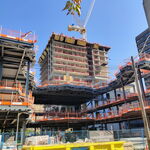snowystar
New Member
Vancouver is better off than Calgary. I'm not so impress with their skytrain capacity. It's packed within years of opening. They miscalculated their ridership and would need a major expensive overhaul at every station to support longer trains. They are also very proud that the newly opened Evergreen Line has 30,000 daily ridership while we call the 50,000 ridership Sheppard subway a white elephant. They did manage to separate the Expo line from the Millennium Line allowing trains to run closer together. Personally I think Vancouver is just wasting money on this so called Skytrain proprietary technology. They could have invested in a heavy rail with wider cars. The SkyTrains could only carries half the capacity of the Yonge line. Their zone system makes it more expensive to travel the same distance vs. Toronto or Calgary. At least they have affordable rapid transit to the airport unlike the pricey UPX that doesn't connect to the TTC. Vancouver's bike network works better cause their city is more dense than Toronto, Montreal or Calgary. They also invested years before TO.
The reason that it's packed is because there are not enough trains. The reason that some stations require expansion is just that the stations are only built to accommodate the projected ridership short and medium term. Some stations are now obviously outgrown this projection. Metrotown, for example, was surrounded by industrial wasteland and single-family homes at the time when it was built, and so the station was designed to accommodate those. Who knows a mega mall would come a few years later and the station would become one of the most heavily used in the system?
None of these you mentioned had anything to do with the technology. Of course they could build huge stations to begin with, but most would just see them as waste as it would take decades to fill up. The separation of Millennium from Expo line actually make the trains run further apart (to be exact, it went from every 108s to about 132s), and this is again because of there are not enough trains. The system is capable of carrying 30,000 pphpd if there are enough trains to run at minimum headway of 75s, and this is quite comparable to subway capacity.
And for the Evergreen comparison... so you think it would be fair to compare the ridership from the second full month of operation with a line that had been running for more than a decade? By the way, the bus route that the line replaced directly only carries about 1/3 of those ridership.




